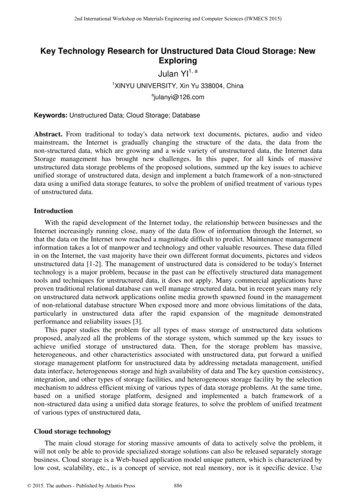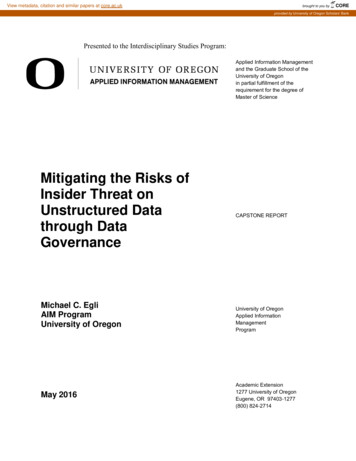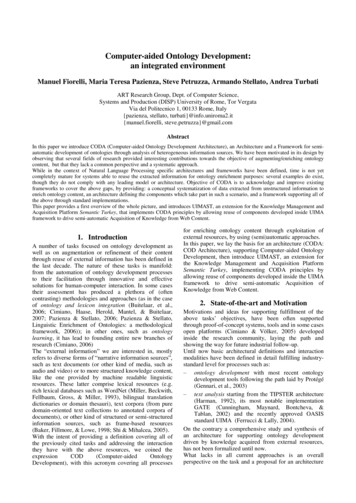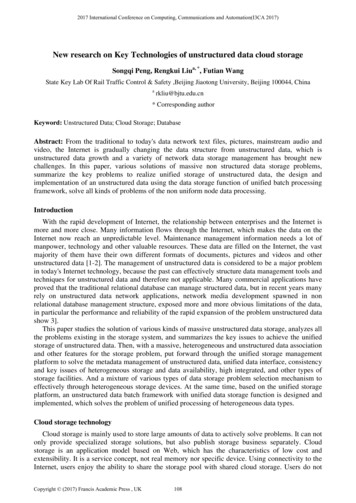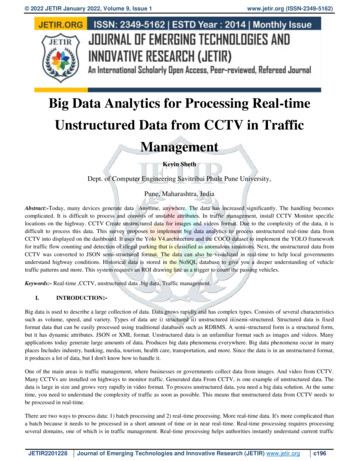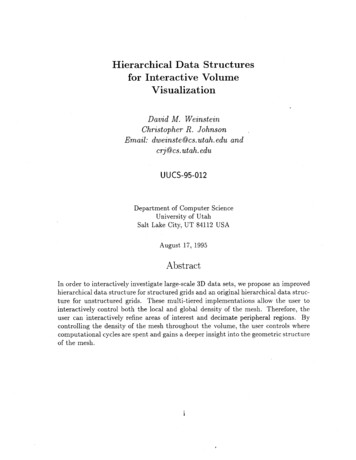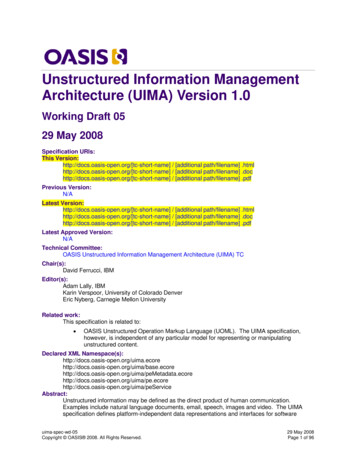
Transcription
Unstructured Information ManagementArchitecture (UIMA) Version 1.0Working Draft 0529 May 2008Specification URIs:This Version:http://docs.oasis-open.org/[tc-short-name] / [additional path/filename] .htmlhttp://docs.oasis-open.org/[tc-short-name] / [additional path/filename] .dochttp://docs.oasis-open.org/[tc-short-name] / [additional path/filename] .pdfPrevious Version:N/ALatest Version:http://docs.oasis-open.org/[tc-short-name] / [additional path/filename] .htmlhttp://docs.oasis-open.org/[tc-short-name] / [additional path/filename] .dochttp://docs.oasis-open.org/[tc-short-name] / [additional path/filename] .pdfLatest Approved Version:N/ATechnical Committee:OASIS Unstructured Information Management Architecture (UIMA) TCChair(s):David Ferrucci, IBMEditor(s):Adam Lally, IBMKarin Verspoor, University of Colorado DenverEric Nyberg, Carnegie Mellon UniversityRelated work:This specification is related to: OASIS Unstructured Operation Markup Language (UOML). The UIMA specification,however, is independent of any particular model for representing or manipulatingunstructured content.Declared XML en.org/uima/peServiceAbstract:Unstructured information may be defined as the direct product of human communication.Examples include natural language documents, email, speech, images and video. The UIMAspecification defines platform-independent data representations and interfaces for softwareuima-spec-wd-05Copyright OASIS 2008. All Rights Reserved.29 May 2008Page 1 of 96
components or services called analytics, which analyze unstructured information and assignsemantics to regions of that unstructured information.Status:This draft has not yet been approved by the OASIS UIMA TC.Technical Committee members should send comments on this specification to the TechnicalCommittee’s email list. Others should send comments to the Technical Committee by using the“Send A Comment” button on the Technical Committee’s web page at http://www.oasisopen.org/committees/uima/.For information on whether any patents have been disclosed that may be essential toimplementing this specification, and any offers of patent licensing terms, please refer to theIntellectual Property Rights section of the Technical Committee web page .uima-spec-wd-05Copyright OASIS 2008. All Rights Reserved.29 May 2008Page 2 of 96
NoticesCopyright OASIS 2008. All Rights Reserved.All capitalized terms in the following text have the meanings assigned to them in the OASIS IntellectualProperty Rights Policy (the "OASIS IPR Policy"). The full Policy may be found at the OASIS website.This document and translations of it may be copied and furnished to others, and derivative works thatcomment on or otherwise explain it or assist in its implementation may be prepared, copied, published,and distributed, in whole or in part, without restriction of any kind, provided that the above copyright noticeand this section are included on all such copies and derivative works. However, this document itself maynot be modified in any way, including by removing the copyright notice or references to OASIS, except asneeded for the purpose of developing any document or deliverable produced by an OASIS TechnicalCommittee (in which case the rules applicable to copyrights, as set forth in the OASIS IPR Policy, mustbe followed) or as required to translate it into languages other than English.The limited permissions granted above are perpetual and will not be revoked by OASIS or its successorsor assigns.This document and the information contained herein is provided on an "AS IS" basis and OASISDISCLAIMS ALL WARRANTIES, EXPRESS OR IMPLIED, INCLUDING BUT NOT LIMITED TO ANYWARRANTY THAT THE USE OF THE INFORMATION HEREIN WILL NOT INFRINGE ANYOWNERSHIP RIGHTS OR ANY IMPLIED WARRANTIES OF MERCHANTABILITY OR FITNESS FOR APARTICULAR PURPOSE.OASIS requests that any OASIS Party or any other party that believes it has patent claims that wouldnecessarily be infringed by implementations of this OASIS Committee Specification or OASIS Standard,to notify OASIS TC Administrator and provide an indication of its willingness to grant patent licenses tosuch patent claims in a manner consistent with the IPR Mode of the OASIS Technical Committee thatproduced this specification.OASIS invites any party to contact the OASIS TC Administrator if it is aware of a claim of ownership ofany patent claims that would necessarily be infringed by implementations of this specification by a patentholder that is not willing to provide a license to such patent claims in a manner consistent with the IPRMode of the OASIS Technical Committee that produced this specification. OASIS may include suchclaims on its website, but disclaims any obligation to do so.OASIS takes no position regarding the validity or scope of any intellectual property or other rights thatmight be claimed to pertain to the implementation or use of the technology described in this document orthe extent to which any license under such rights might or might not be available; neither does itrepresent that it has made any effort to identify any such rights. Information on OASIS' procedures withrespect to rights in any document or deliverable produced by an OASIS Technical Committee can befound on the OASIS website. Copies of claims of rights made available for publication and anyassurances of licenses to be made available, or the result of an attempt made to obtain a general licenseor permission for the use of such proprietary rights by implementers or users of this OASIS CommitteeSpecification or OASIS Standard, can be obtained from the OASIS TC Administrator. OASIS makes norepresentation that any information or list of intellectual property rights will at any time be complete, orthat any claims in such list are, in fact, Essential Claims.The names "OASIS", [insert specific trademarked names and abbreviations here] are trademarks ofOASIS, the owner and developer of this specification, and should be used only to refer to the organizationand its official outputs. OASIS welcomes reference to, and implementation and use of, specifications,while reserving the right to enforce its marks against misleading uses. Please see http://www.oasisopen.org/who/trademark.php for above guidance.uima-spec-wd-05Copyright OASIS 2008. All Rights Reserved.29 May 2008Page 3 of 96
Table of Contents1Introduction. 61.1 Terminology . 71.2 Normative References . 71.3 Non-Normative References . 82Basic Concepts and Terms . 93Elements of the UIMA Specification . 113.1 Common Analysis Structure (CAS) . 113.2 Type System Model . 113.3 Base Type System. 133.4 Abstract Interfaces. 133.5 Behavioral Metadata. 143.6 Processing Element Metadata. 153.7 WSDL Service Descriptions. 164Full UIMA Specification . 174.1 The Common Analysis Structure (CAS) . 174.1.1 Basic Structure: Objects and Slots. 174.1.2 Relationship to Type System. 174.1.3 The XMI CAS Representation . 184.1.4 Formal Specification. 184.2 The Type System Model. 194.2.1 Ecore as the UIMA Type System Model . 194.2.2 Formal Specification. 194.3 Base Type System. 204.3.1 Primitive Types . 204.3.2 Annotation and Sofa Base Type System . 204.3.3 View Base Type System . 224.3.4 Source Document Information. 244.3.5 Formal Specification. 254.4 Abstract Interfaces. 254.4.1 Abstract Interfaces URL . 254.4.2 Formal Specification. 264.5 Behavioral Metadata. 304.5.1 Behavioral Metadata UML. 304.5.2 Behavioral Metadata Elements and XML Representation . 314.5.3 Formal Semantics for Behavioral Metadata . 314.5.4 Formal Specification. 334.6 Processing Element Metadata. 364.6.1 Elements of PE Metadata. 364.6.2 Formal Specification. 394.7 Service WSDL Descriptions. 394.7.1 Overview of the WSDL Definition . 394.7.2 Delta Responses . 434.7.3 Formal Specification. 43uima-spec-wd-05Copyright OASIS 2008. All Rights Reserved.29 May 2008Page 4 of 96
A.B.Acknowledgements . 44Examples (Not Normative) . 45B.1 XMI CAS Example. 45B.1.1 XMI Tag. 45B.1.2 Objects . 45B.1.3 Attributes (Primitive Features) . 46B.1.4 References (Object-Valued Features) . 47B.1.5 Multi-valued Features . 47B.1.6 Linking an XMI Document to its Ecore Type System . 48B.1.7 XMI Extensions . 48B.2 Ecore Example . 49B.2.1 An Introduction to Ecore . 49B.2.2 Differences between Ecore and EMOF . 50B.2.3 Example Ecore Model. 51B.3 Base Type System Examples . 52B.3.1 Sofa Reference . 52B.3.2 References to Regions of Sofas . 53B.3.3 Options for Extending Annotation Type System . 53B.3.4 An Example of Annotation Model Extension. 54B.3.5 Example Extension of Source Document Information . 55B.4 Abstract Interfaces Examples. 56B.4.1 Analyzer Example . 56B.4.2 CAS Multiplier Example . 56B.5 Behavioral Metadata Examples . 57B.5.1 Type Naming Conventions. 58B.5.2 XML Syntax for Behavioral Metadata Elements . 60B.5.3 Views. 61B.5.4 Specifying Which Features Are Modified. 62B.5.5 Specifying Preconditions, Postconditions, and Projection Conditions. 62B.6 Processing Element Metadata Example . 63B.7 SOAP Service Example . 64C. Formal Specification Artifacts. 66C.1 XMI XML Schema . 66C.2 Ecore XML Schema . 69C.3 Base Type System Ecore Model. 74C.4 PE Metadata and Behavioral Metadata Ecore Model. 76C.5 PE Metadata and Behavioral Metadata XML Schema . 78C.6 PE Service WSDL Definition . 81C.7 PE Service XML Schema (uima.peServiceXMI.xsd) . 91D. Revision History. 95uima-spec-wd-05Copyright OASIS 2008. All Rights Reserved.29 May 2008Page 5 of 96
11 Introduction23456Unstructured information may be defined as the direct product of human communication. Examplesinclude natural language documents, email, speech, images and video. It is information that was notspecifically encoded for machines to process but rather authored by humans for humans to understand.We say it is “unstructured” because it lacks explicit semantics (“structure”) required for applications tointerpret the information as intended by the human author or required by the end-user application.789101112131415Unstructured information may be contrasted with the information in classic relational databases where theintended interpretation for every field data is explicitly encoded in the database by column headings.Consider information encoded in XML as another example. In an XML document some of the data iswrapped by tags which provide explicit semantic information about how that data should be interpreted.An XML document or a relational database may be considered semi-structured in practice, because thecontent of some chunk of data, a blob of text in a text field labeled “description” for example, may be ofinterest to an application but remain without any explicit tagging—that is, without any explicit semantics orstructure.161718192021222324Unstructured information represents the largest, most current and fastest growing source of knowledgeavailable to businesses and governments worldwide. The web is just the tip of the iceberg. Consider, forexample, the droves of corporate, scientific, social and technical documentation including best practices,research reports, medical abstracts, problem reports, customer communications, contracts, emails andvoice mails. Beyond these, consider the growing number of broadcasts containing audio, video andspeech. These mounds of natural language, speech and video artifacts often contain nuggets ofknowledge critical for analyzing and solving problems, detecting threats, realizing important trends andrelationships, creating new opportunities or preventing disasters.2526272829For unstructured information to be processed by applications that rely on specific semantics, it must befirst analyzed to assign application-specific semantics to the unstructured content. Another way to say thisis that the unstructured information must become “structured” where the added structure explicitlyprovides the semantics required by target applications to interpret the data correctly.30313233343536An example of assigning semantics includes labeling regions of text in a text document with appropriateXML tags that, for example, might identify the names of organizations or products. Another example mayextract elements of a document and insert them in the appropriate fields of a relational database or usethem to create instances of concepts in a knowledgebase. Another example may analyze a voice streamand tag it with the information explicitly identifying the speaker or identifying a person or a type of physicalobject in a series of video frames.3738394041In general, we refer to a segment of unstructured content (e.g., a document, a video etc.) as an artifactand we refer to the act of assigning semantics to a region of an artifact as analysis. A softwarecomponent or service that performs the analysis is referred to as an analytic. The results of the analysisof an artifact by an analytic are referred to as artifact metadata.424344454647Analytics are typically reused and combined together in different flows to perform application-specificaggregate analyses. For example, in the analysis of a document the first analytic may simply identify andlabel the distinct tokens or words in the document. The next analytic might identify parts of speech, thethird might use the output of the previous two to more accurately identify instances of persons,organizations and the relationships between them48uima-spec-wd-05Copyright OASIS 2008. All Rights Reserved.29 May 2008Page 6 of 96
495051525354While different platform-specific, software frameworks have been developed with varying features insupport of building and integrating component analytics (e.g., Apache UIMA, Gate, Catalyst, Tipster,Mallet, Talent, Open-NLP, LingPipe etc.), no clear standard has emerged for enabling the interoperabilityof analytics across platforms, frameworks and modalities (text, audio, video, etc.) Significant advances inthe field of unstructured information analysis require that it is easier to combine best-of-breed analyticsacross these dimensions.55565758The UIMA specification defines platform-independent data representations and interfaces for text andmulti-modal analytics. The principal objective of the UIMA specification is to support interoperabilityamong analytics. This objective is subdivided into the following four design goals:596061621. Data Representation. Support the common representation of artifacts and artifact metadataindependently of artifact modality and domain model and in a way that is independent of theoriginal representation of the artifact.636465662. Data Modeling and Interchange. Support the platform-independent interchange of analysis data(artifact and its metadata) in a form that facilitates a formal modeling approach and alignment withexisting programming systems and standards.6768693. Discovery, Reuse and Composition. Support the discovery, reuse and composition ofindependently-developed analytics.7071724. Service-Level Interoperability. Support concrete interoperability of independently developedanalytics based on a common service description and associated SOAP bindings.737475The text of this specification is normative with the exception of the Introduction and Examples (AppendixB).761.1 Terminology777879The key words “MUST”, “MUST NOT”, “REQUIRED”, “SHALL”, “SHALL NOT”, “SHOULD”, “SHOULDNOT”, “RECOMMENDED”, “MAY”, and “OPTIONAL” in this document are to be interpreted as describedin [RFC2119].801.2 Normative References81828384[RFC2119] S. Bradner, Key words for use in RFCs to Indicate Requirement Levels,http://www.ietf.org/rfc/rfc2119.txt, IETF RFC 2119, March 1997.[MOF1]Object Management Group. Meta Object Facility (MOF) 2.0 Core .pdf8586[OCL1]Object Management Group. Object Constraint Language Version /ocl.htm8788[OSGi1]OSGi Alliance. OSGi Service Platform Core Specification, Release 4, Version 4.1.Available from http://www.osgi.org.8990[SOAP1]W3C. SOAP Version 1.2 Part 1: Messaging Framework (Second L1]Object Management Group. Unified Modeling Language (UML), version al/uml.htm9394[XMI1]Object Management Group. XML Metadata Interchange (XMI) Specification, Version a-spec-wd-05Copyright OASIS 2008. All Rights Reserved.29 May 2008Page 7 of 96
9596[XML1]W3C. Extensible Markup Language (XML) 1.0 (Fourth Edition).http://www.w3.org/TR/REC-xml97[XML2]W3C. Namespaces in XML 1.0 (Second Edition). http://www.w3.org/TR/REC-xml-names/9899[XMLS1]XML Schema Part 1: Structures Second Edition. structures.html100101[XMLS2]XML Schema Part 2: Datatypes Second Edition. datatypes.html.1021031.3 Non-Normative ittees/tc home.php?wg abbrev 09[EMF1]The Eclipse Modeling Framework (EMF) topic 110[EMF2]Budinsky et al. Eclipse Modeling Framework. Addison-Wesley. 2004.111112113[EMF3]Budinsky et al. Eclipse Modeling Framework, Chapter 2, Section ]David Ferrucci, William Murdock, Chris Welty, “Overview of Component Services forKnowledge Integration in UIMA (a.k.a. SUKI)” IBM Research Report RC24074116117[XMI2]Grose et al. Mastering XMI. Java Programming with XMI, XML, and UML. John Wiley &Sons, Inc. 2002uima-spec-wd-05Copyright OASIS 2008. All Rights Reserved.29 May 2008Page 8 of 96
1182 Basic Concepts and Terms119This specification defines and uses the following terms:120121122123124Unstructured Information is typically the direct product of human communications. Examples includenatural language documents, email, speech, images and video. It is information that was not encoded formachines to understand but rather authored for humans to understand. We say it is “unstructured”because it lacks explicit semantics (“structure”) required for computer programs to interpret theinformation as intended by the human author or required by the application.125126127128129Artifact refers to an application-level unit of information that is subject to analysis by some application.Examples include a text document, a segment of speech or video, a collection of documents, and astream of any of the above. Artifacts are physically encoded in one or more ways. For example, one wayto encode a text document might be as a Unicode string.130131132Artifact Modality refers to mode of communication the artifact represents, for example, text, video orvoice.133134135136137138139Artifact Metadata refers to structured data elements recorded to describe entire artifacts or parts ofartifacts. A piece of artifact metadata might indicate, for example, the part of the document thatrepresents its title or the region of video that contains a human face. Another example of metadata mightindicate the topic of a document while yet another may tag or annotate occurrences of person names in adocument etc. Artifact metadata is logically distinct from the artifact, in that the artifact is the data beinganalyzed and the artifact metadata is the result of the analysis – it is data about the artifact.140141142143144145146Domain Model refers to a conceptualization of a system, often cast in a formal modeling language. In thisspecification we use it to refer to any model which describes the structure of artifact metadata. A domainmodel provides a formal definition of the types of data elements that may constitute artifact metadata. Forexample, if some artifact metadata represents the organizations detected in a text document (the artifact)then the type Organization and its properties and relationship to other types may be defined in a domainmodel which the artifact metadata instantiates.147148Analysis Data is used to refer to the logical union of an artifact and its metadata.149150151152153154155Analysis Operations are abstract functions that perform some analysis on artifacts and/or their metadataand produce some result. The results may be the addition or modification to artifact metadata and/or thegeneration of one or more artifacts. An example is an “Annotation” operation which may be defined by thetype of artifact metadata it produces to describe or annotate an artifact. Analysis operations may beultimately bound to software implementations that perform the operations. Implementations may berealized in a variety of software approaches, for example web-services or Java classes.156157An Analytic is a software object or network service that performs an Analysis Operation.158159A Flow Controller is a component or service that decides the workflow between a set of analytics.160161162A Processing Element (PE) is either an Analytic or a Flow Controller. PE is the most general type ofcomponent/service that develope
OASIS Unstructured Information Management Architecture (UIMA) TC Chair(s): David Ferrucci, IBM Editor(s): Adam Lally, IBM Karin Verspoor, University of Colorado Denver Eric Nyberg, Carnegie Mellon University Related work: This specification is related to: OASIS Unstructured Operation Markup Language (UOML). The UIMA specification,


